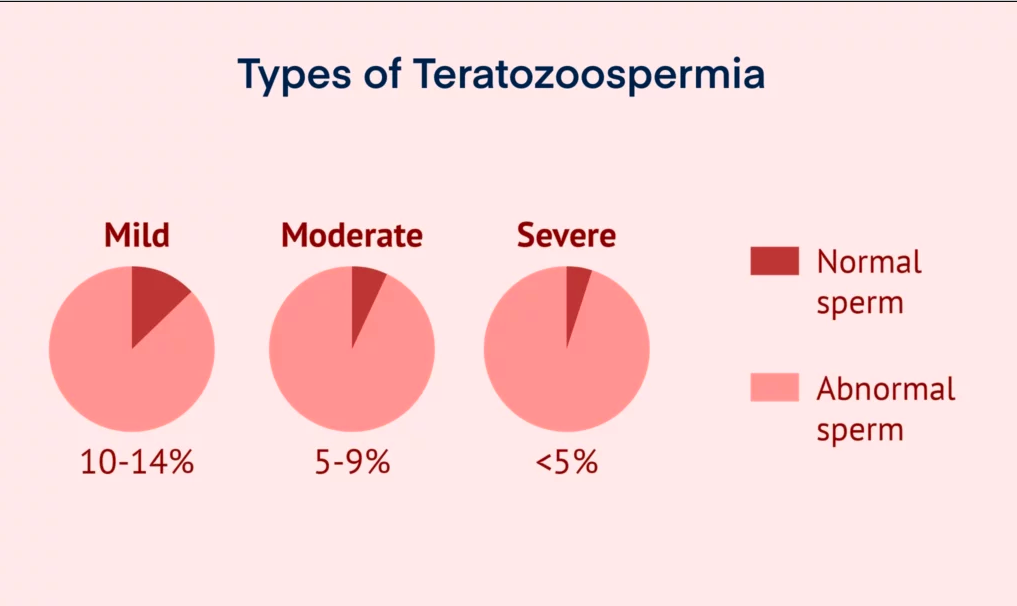
01 Feb Understanding Teratozoospermia: Causes, Symptoms, and Treatment for Improved Fertility
Teratozoospermia is a condition characterized by the presence of a higher-than-normal percentage of abnormally shaped sperm in a man’s semen. Sperm morphology is an important factor in male fertility, and abnormalities in sperm shape can impact the ability of sperm to fertilize an egg. Here are the causes, symptoms, and treatment options for teratozoospermia: Teratozoospermia is a term that might sound complex, but understanding its causes, symptoms, and treatment is crucial for individuals and couples navigating fertility challenges. In this article, we will delve into the world of teratozoospermia, shedding light on its various aspects.

Causes:
- Genetic Factors: Some cases of teratozoospermia may have a genetic basis, where a man inherits a predisposition for abnormal sperm morphology.
- Environmental Factors: Exposure to certain environmental factors such as toxins, chemicals, or radiation can contribute to sperm abnormalities.
- Varicocele: A varicocele is a swelling of the veins that drain the testicle, and it can lead to increased testicular temperature, affecting sperm production and morphology.
- Infections: Infections of the reproductive tract, such as sexually transmitted infections, can impact sperm morphology.
- Hormonal Imbalances: Disruptions in hormonal levels can affect sperm production and morphology.
- Lifestyle Factors: Smoking, excessive alcohol consumption, drug use, and poor dietary habits can contribute to teratozoospermia.
Symptoms:
Teratozoospermia often doesn’t have noticeable symptoms. The condition is usually identified through a semen analysis, which is part of a male fertility evaluation. However, if teratozoospermia is severe, it may contribute to infertility.
Treatment:
- Lifestyle Changes: Adopting a healthy lifestyle can improve sperm quality. This includes maintaining a balanced diet, regular exercise, avoiding smoking and excessive alcohol intake, and managing stress.
- Treating Underlying Conditions: If an underlying medical condition or infection is identified, treating it can sometimes improve sperm morphology.
- Assisted Reproductive Techniques (ART): In cases of severe teratozoospermia, where natural conception is challenging, assisted reproductive technologies such as in vitro fertilization (IVF) or intracytoplasmic sperm injection (ICSI) may be recommended. These techniques involve selecting and using the healthiest sperm for fertilization.
- Hormone Therapy: In cases where hormonal imbalances are contributing to teratozoospermia, hormone therapy may be considered.
- Varicocele Repair: Surgical correction of a varicocele may improve sperm morphology in some cases.
It’s important for couples experiencing fertility issues to consult with a healthcare professional or a fertility specialist for a comprehensive evaluation and personalized treatment plan based on the specific circumstances.
Teratozoospermia is a term that might sound complex, but understanding its causes, symptoms, and treatment is crucial for individuals and couples navigating fertility challenges. In this article, we will delve into the world of teratozoospermia, shedding light on its various aspects.
Causes of Teratozoospermia: Teratozoospermia can be attributed to a variety of factors. Genetic predispositions, environmental influences, and lifestyle choices can all play a role in the abnormal morphology of sperm. Unraveling these causes is the first step towards effective management.
Symptoms of Teratozoospermia: Recognizing the symptoms of teratozoospermia is vital for early intervention. Abnormal sperm morphology, impaired fertility, and recurrent miscarriages are key indicators. Understanding these signs empowers individuals to seek timely medical attention.
Diagnosis: Accurate diagnosis is fundamental in addressing teratozoospermia. Semen analysis, advanced reproductive tests, and genetic testing are essential components of the diagnostic process. These tests provide valuable insights into the specific challenges individuals may face.
Impact on Fertility: Teratozoospermia can significantly impact fertility. Couples grappling with this condition need to comprehend the challenges they may encounter. Moreover, understanding the treatment options available is essential for making informed decisions.
Treatment for Teratozoospermia: Addressing teratozoospermia involves a multi-faceted approach. Lifestyle changes, medical interventions, and assisted reproductive technologies are among the strategies employed to improve sperm morphology and enhance fertility.
Improving Sperm Morphology Naturally: In addition to medical interventions, individuals can take steps to naturally improve sperm morphology. Dietary recommendations, regular exercise, and stress management play crucial roles in enhancing overall reproductive health.
Seeking Professional Help: Consulting with a fertility specialist is a pivotal step in managing teratozoospermia. Open communication with healthcare professionals ensures personalized and effective treatment plans, fostering hope for couples facing fertility challenges.
Emotional Impact on Couples: Dealing with fertility challenges goes beyond the physical aspects. Couples navigating teratozoospermia may experience emotional upheaval. Seeking support and developing coping mechanisms are integral to the journey.
Future Trends in Teratozoospermia Research: Advancements in reproductive medicine continue to offer hope for those with teratozoospermia. Staying informed about emerging trends and breakthroughs in research provides optimism for the future.
Case Studies: Real-life experiences and success stories offer inspiration and insights into overcoming teratozoospermia. These stories serve as beacons of hope for individuals and couples on their fertility journey.
Myths and Facts about Teratozoospermia: Dispelling common misconceptions surrounding teratozoospermia is essential. Providing accurate information helps individuals make informed decisions and fosters a supportive community.
Conclusion: Teratozoospermia may present challenges, but with knowledge and proactive measures, individuals and couples can navigate this journey. Recognizing the impact, seeking professional help, and embracing a holistic approach are key to managing teratozoospermia effectively.
FAQs:
- What are the common causes of teratozoospermia?
- Teratozoospermia can result from genetic factors, environmental influences, and lifestyle choices.
- Can lifestyle changes improve sperm morphology?
- Yes, adopting a healthy lifestyle, including a balanced diet and regular exercise, can positively impact sperm morphology.
- Is teratozoospermia treatable?
- Teratozoospermia is manageable through a combination of lifestyle changes, medical interventions, and assisted reproductive technologies.
- How does teratozoospermia affect fertility?
- Teratozoospermia can impair fertility by causing abnormal sperm morphology, making it challenging for sperm to fertilize an egg.
- What support is available for couples dealing with teratozoospermia?
- Couples can find support through fertility specialists, support groups, and counseling services.




No Comments